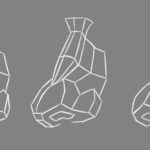Hi and welcome back to the third lesson in this series on how to draw perspective.
Just as a quick recap, in the previous lessons, we cover the different elements of perspective such as vanishing points, horizon line, eye level, the picture plane, cone of vision, and a lot more.
If you missed those lessons, be sure to click on the link below to watch them now:
Perspective Lesson 1 – Introduction To Drawing Perspective
Perspective Lesson 2 – Elements of A Perspective Drawing
So there are basically 3 main types of perspective. There’s one point perspective, two point perspective, and three point perspective. There is much to say about each type of perspective, for now, we will have to narrow things down.
In this lesson, we are going to cover what exactly one point perspective is and how it works.
What Is One Point Perspective?
One point perspective means that you only have one vanishing point in a perspective drawing. One thing to note about one point perspective is that one can only draw an object in 1-point if that object is near (or at the middle of) the observer’s field of vision. If the object begin to stray too far outside the observer’s center of vision, the object will begin to appear in two point or three point perspective.
(For a detail explanation of how 1 point perspective works as well as several examples, please refer to the video above.)
In tomorrow’s video, we are going to go through a drawing exercise and show you how to draw one point perspective.
Now if you are already subscribed to my free drawing newsletter, all you have to do is watch your inbox for an email from me tomorrow.
But if you have not signed up yet, you can do that for free by entering your email into the form below…
So that’s it for today’s lesson.
If you like this lesson, please hit the “LIKE” button on this page and also share it with all your friends using the social sharing buttons on this page.
Please leave a comment below to let me know what you think.
Thank you for visiting and I’ll see you tomorrow!

![Linear Perspective Drawing Lesson Series [1 of 6] – Introduction To Drawing Perspective In Art](https://mydrawingtutorials.com/wp-content/themes/Extra/images/post-format-thumb-text.svg)
![Linear Perspective Drawing Lesson Series [4 of 6] – How To Draw One Point Perspective](https://mydrawingtutorials.com/wp-content/uploads/2013/08/One-Point-Perspective-Drawing-Exercise.jpg)
![Linear Perspective Drawing Lesson Series [5 of 6] – Drawing a Room In Perspective Tutorial](https://mydrawingtutorials.com/wp-content/uploads/2013/07/drawing-a-room-in-perspective.jpg)






Ethan, this is very well expressed and with excellent examples. I am a self taught Portrait artist (Portraits By Leila) that has mainly painted using my eye to tell me what is right and what is wrong. I decided at this late date (I’m 71) to research the true right way to do perspectives. I’m glad I found your tutorials. Well done!
Ethan,excellent! But I have difficulty knowing where to put the vanishing points and end up with queerlooking perspective.
One common reason for a weird looking drawing is because the vanishing points are too close together. It causes the drawing to look distorted. I would guess that is your problem. Try placing the vanishing points much further apart. You can even place them off the drawing paper.
The third lesson in perspective is a little repetitive. Otherwise enjoyable
Thanks for the feedback. I’ll keep that in mind when I re-make this series. I do have a tendency to be to repetitive and give out too much details. I’ve been working on scripting out my videos so I can make everything much more clear and concise.
Thank you for this lesson. The illustrations are great examples.
Hi I was wondering in this last tutorial how you establishes where the vanishing point was on the left of the drawing. Thanks COLLEEN
Thank you Ethan, I know you explained this very well but I find my self struggling to really grasp it. I hope I will be able to get a good grasp on it?
Thank you very much for such good explanaciones both typed and spoken in addition to the illustrations used.
Good work!
Thank you very much. Have a nice day.
Hi thank you for the info great video. i have a question.. when you take about the vanishing point in min 1:48 where is the person located?? am a bit confused is he on the opposite side of the vanishing point?… thanks
Hi thank you for the info great video. i have a question.. when you take about the vanishing point in min 1:48 where is the person located?? am a bit confused is he on the opposite side of the vanishing point?… thanks